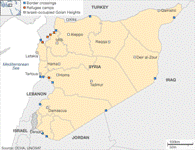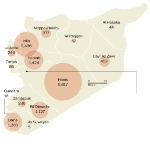26 April 2012, Geneva, Switzerland - Several important media and the press have been using data produced by UNOSAT (UNITAR Operational Satellite Applications Programme) to add objectivity to their information on the evolving situation in Syria. Most recently, the BBC has posted a map built on data released by UNOSAT and OCHA (Office for the Coordination of Humanitarian affairs) concerning the localisation and number of casualties. Earlier this week the Washington Post had done the same and posted an analysis of the consequences of the clashes in the country. Others media using UNOSAT data include Fox News, the New York Times, and The National Post of Canada.
UNOSAT has been active also in support of the UN Office of the High Commissioner for Human Rights which deployed a fact finding mission to Syria following which the Office of the High Commissioner had released an alarming report. Since then, UNOSAT has continued its data preparedness work as well as the mapping from space of refugees flowing into neighbouring countries in support of UN humanitarian agencies, using commercial satellite imagery available on the public market.  UNOSAT started developing geospatial information and analysis in support of the UN system in the area of human rights after researching the human security dimension of satellite imagery analysis back in 2009. Since then, UNOSAT has developed tools and methodologies that allowed the team to set up a satellite analysis service able to respond to requests for support emanating from the United Nations and the international community alike.
UNOSAT started developing geospatial information and analysis in support of the UN system in the area of human rights after researching the human security dimension of satellite imagery analysis back in 2009. Since then, UNOSAT has developed tools and methodologies that allowed the team to set up a satellite analysis service able to respond to requests for support emanating from the United Nations and the international community alike.
 The service is similar to the celebrated UNOSAT Humanitarian Rapid Mapping Service, active since 2003 and used in over 250 humanitarian crises and natural disasters worldwide. UNOSAT research on applied human security mapping service enjoyed the initial support of the MacArthur Foundation, while discussions are being held with various donors on the viability of a stronger and more articulate service in the near future.
The service is similar to the celebrated UNOSAT Humanitarian Rapid Mapping Service, active since 2003 and used in over 250 humanitarian crises and natural disasters worldwide. UNOSAT research on applied human security mapping service enjoyed the initial support of the MacArthur Foundation, while discussions are being held with various donors on the viability of a stronger and more articulate service in the near future.
Images: top left, courtesy of BBC news; bottom right, courtesy of The Washington Post

